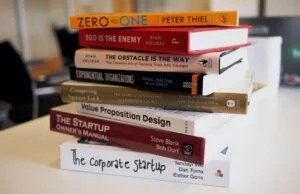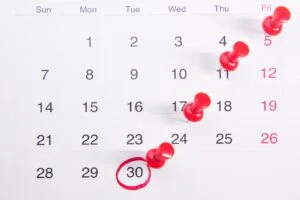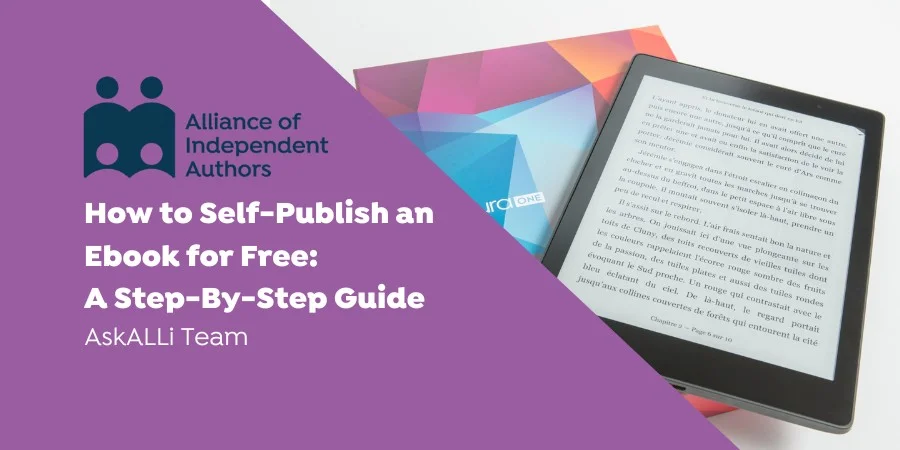With so many authors now working with professional editors, designers and marketers, you might think it’s no longer possible to self-publish without shelling out. But self-publishing is still accessible to you if you’ve got limited funds. Here’s ALLi‘s fully updated guidance for producing an e-book for free (or almost free).
This guide assumes you have access to the internet and a computer. If you don’t, your local library or community center might give you free or low-cost access. At the end of this feature, you’ll also find recommendations for where to prioritize investment if you have some budget to work with, or if you decide to continue to build your author business.
Start with e-books: how to self publish an e-book for free
An e-book is the most economical way to produce your first book, as once the e-book is produced there are no ongoing print or distribution costs.
For fiction in particular, most surveys agree that e-books make up the majority of indie book sales, so e-books can be an effective way to share your work.
The other main formats, print and audiobooks, require some unavoidable investments, but they can make good business sense if you have the budget. We’ll discuss this later.
- Complete your manuscript and undertake editorial development
Your publishing journey can’t begin until you have a fully complete manuscript. So don’t get lured into the publishing processes before then.
And don’t publish without feedback on the manuscript. This is a standard step for every writer, no matter how experienced – to show the manuscript to others, who’ll advise on problems you haven’t yet spotted and improvements you can make.
Professional editors will be beyond your budget, so make good use of beta readers. These might be friends, colleagues or contacts from your writing networks who love to read in your genre. Also, look for self-editing tips around the internet, such as this ALLi blogpost: what you can learn from professional editors.
Plan your editing process in phases to mirror the traditional publishing processes. A typical process would be:
- Overall manuscript critique: this involves assessing the content. For fiction it looks at storyline, voice, character development and suitability for the genre. For non-fiction, flow, tone and completeness. For poetry, a critique looks at tone, vision, flair and coherence.
- Line edit: this is an optional step if there are particular difficulties with the writing style.
- Copyedit: this tackles technical issues such as inconsistencies and factual inaccuracies, and also spelling, punctuation and grammar. For some of this you can use free or almost free online grammar and proofing tools like Grammarly or ProWritingAid, though they won’t pick up all errors so it’s worth asking a friend or relative who has strong writing skills. They’ll also spot the mistakes a program can’t – such as inconsistencies, illogicalities and problems with overall readability.
-

Photo by Daria Nepriakhina 🇺🇦 on Unsplash
Research the market
You need to understand where you fit in the market and how to present your book. Find 10 recent, successful books in your genre. These are known as comparison titles.
Study them from a publishing perspective. Analyse their covers, look at their blurbs, read their sales descriptions, look at reviews and see what people like about them. This exercise will be a tremendous help as you work through the other steps.
Ideally, you should read the books you are competing with, so you know where you fit in.
- Finalise your e-book title
Your title is the first piece of information a reader will see when they find your book, so this is an important decision. Once you have researched your competition you might have fresh ideas about your title, to bring it in line with others in your genre and and to set up the right expectations in readers.
Business coach and former publisher Michael Hyatt has this useful acronym for book titling-Promise, Intrigue, Need, Content (PINC).
- Promise: make sure readers know what to expect from your book.
- Intrigue: entice a reader to pick up your book.
- Need: if there is a problem that your book answers, make this clear.
- Content: keep it simple by stating the content type up front.
- Format your manuscript
This is the process of setting up your e-book so that the chapter breaks, headings, paragraphs, images, graphics and any other visible elements display correctly on the reader’s device. This is a key moment when your manuscript begins to look like a professional book.
Your e-book files must be in one of the correct formats to upload successfully. Amazon has this quick article on e-book formats.
Formatting for e-book is straightforward, as the reader’s device will do a lot of the work for you – they’ll set their preferences for print size, size of screen and font, so you don’t have to make the kind of typesetting decisions that are necessary for a print book.
There are many websites that offer free online tools to help you create your e-book file through widely available packages such as Word. A great example is the Draft2Digital e-book Formatting Guide.
- Complete the final proof
Now you need to do one final check, reviewing your manuscript for any mistakes that have been missed, or have arisen during the editing process. You may also spot awkward copy or page breaks produced in the formatting.
It’s difficult to do this yourself, as you are too close to your work, so try to get a fresh eye on the book. Sometimes newly trained proofreaders will run a proof for free in return for practice and a testimonial. You may find these on writing forums. Otherwise, your trusted supporters might help. Don't worry if they aren't keen on your genre, this doesn't matter at this stage, as they are looking purely for errors.
- Design your e-book cover
Now you have your words ready to go, you can add the cover. Free online design tools, such as Canva, can create e-book covers.
Here’s where your research will be useful. You want your book to fit in with its genre or category, so notice how your competitors’ covers are designed. For example do they tend to use photography or illustrations? Are they colorful and patterned, or somber and subtle? It may be tempting to try to stand out from the crowd, but readers look for books that are similar to those they already enjoy. Fitting in can be more successful than standing out. ALLi partner member 1106 Design has shared some great tips for designing a book cover in this post: How to Design a Great Book Cover.
- Write a compelling marketing blurb
You need a marketing blurb to sell the book, and it’s worth spending a good deal of time on this. Not only will it sit on your sales pages, you will also use it in your marketing activity.
It needs to hit the right notes – and not just for readers, but for search engines, which will bring readers to you. For this it needs to use the right keywords, a concept known as metadata. Here’s a post about keywords and metadata.
Descriptions are usually about 200 words, and should describe your book in an engaging way.
As you hone the description, keep checking comparison titles to ensure you match the tone and approach of successful books in your category. Also, use short sentences and paragraph breaks so that a busy buyer can scan the description as easily as possible. You can find more tips on the ALLi blog in Writing a Book Blurb.
- Launch your author website
It’s vital to have your own website. Even if you’re on social media such as Facebook or Instagram, your website is your central hub, showcasing your work and getting readers onto your mailing list.

Photo by Thought Catalog on Unsplash
You can get websites completely free from organizations such as WordPress.com, but you’ll have limited options for adding other functionality and you’ll have no control if they withdraw their free service. But a free site might serve you well if your needs are simple – to create a hub for information and a contact form.
If you have longer-term plans, there are low-cost options for building websites, including Wix and Square Space. Often there are offers that will save you money. WordPress offers free tools for building websites on a range of platforms.
You’ll need a domain name. Usually people use use their author name. If it’s taken, you can also add “Author” (for example, SarahSmithAuthor.com).
Thinking longer-term still, you can sell books directly from your website. If you plan to do this, you’ll need a site with e-commerce options. More on author websites can be found here: How to Create an Author Website that Converts.
- Write your indie author page
As well as writing material for your website, you need to write an author page on the retail platforms where you intend to sell, such as Amazon, Apple Books, Kobo and Google. Ensure you have a good, clear author photo that enhances what you want to say about yourself as an author. Usually a picture against a plain background looks professional. In your biography, don’t forget to share a bit about yourself, your books and your website address, and encourage readers to follow you on social media if you are active.
- Build your e-book reviews
Before you publish, try to gather testimonials and reviews. Reviews are important for showing sales platforms that readers enjoy your work. They also reassure readers that your book is of high quality.
Prepare advance reader copies (ARCs) to send to online reviewers and book bloggers in your genre, and contact them asking if they’d like to see your book.
Some reviewers will post to the sales platforms when the book goes on sale, and you can use reviews in other ways, such as on your own website. Or you can add them to the book cover.
Remember, they must be honest reviews that are not paid for, or they will contravene sales platform rules. For more on building book reviews, take a look at How to get your first 50 book reviews.
- Upload to your book selling platforms
ALLi recommends going wide with your books, which means selling on multiple platforms. But if you are undertaking this process for the first time, you’ll probably want to start with the biggest e-book platform, Amazon. Set up a free account on the Amazon KDP platform, then follow the easy steps to upload your manuscript and your cover art. Fill in the book description you wrote earlier.
Amazon also offers KDP Select, which is an exclusivity package. This means Amazon will offer your book to people on the subscription service, and you will be paid by the number of pages read, but you won’t be allowed to sell your e-book on other platforms. You can opt out of this arrangement after 90 days or decide to continue if it suits you. Find more information on KDP Select here: KDP Select information.
- Select your price point
It’s time to select the price. Try to keep it around the same as the books you are competing with.
Platforms such as Amazon take a small commission for your use of the platform, and will show you how much you will receive per sale – the royalty payment.
- Select book keywords and categories
Also, on the upload pages, you can add keywords and categories for the platform’s own use, which help readers find your book. Once again, revisit your 10 comparison titles, see how they are listed on platforms such as Amazon and choose those categories.
Don’t be afraid to change these as you learn more about the categories your work should be in and the keywords your readers are looking for. It costs nothing but time and thought.
- Give your book an ISBN
International Standard Book Numbers (ISBNs) are unique identifier numbers for books – like a car number plate. Any book to be sold on a sales platform needs an ISBN. On a print book, you can see the ISBN alongside the barcode on the back cover, and e-books need ISBNs too.
This is a point where you might spend money. Or you might not. The sales platforms like Amazon and Kobo offer free ISBNs for e-books. That then makes them the publisher of record, but in practical terms there is no disadvantage to this; it doesn’t, for instance, mean the sales platform owns the copyright.
But if you might publish many books, you might prefer to be recorded as the publisher, so you might want to buy ISBNs that are registered to your name or your imprint name. And if you want to make print editions, you’ll need ISBNs for most of the print suppliers.
ISBNs are usually sold in bundles of 10 or 100, and you need one ISBN per edition, which means you need separate ISBNs for e-book and print editions. Cost varies according to which country you’re in – use the International ISBN Agency to find the agency that manages your country’s ISBN registrations.
-

Photo by Towfiqu barbhuiya on Unsplash
Select a publishing date
Once you have completed all the details for your book, you can save it as a draft or choose a release date. This has two options: ‘release now’, meaning people can buy it straight away, or ‘pre-order’. The second option works well if you plan to drive people to the sales page ahead of launch. If you get a selection of pre-orders, your ranking will be higher when the book goes live, as all those orders will go out at the same time.
- Find book marketing and promotion opportunities
Start work on this before your launch.
You need to tell people your book exists. There are lots of zero-cost ways to do this – contact local papers and radio stations, attend literary events and book fairs, give talks at local schools and community groups. Online, you could offer to speak on a podcast, or write a blogpost for another author in your genre. The more you reach out and network, the more confident you will become talking about your book.
Ideally, plan a few activities for when your book goes live and across the first few months. Fit as needed around other commitments.
- Monitor your data and adapt
Check how your sales are doing. Make regular visits to your seller platform dashboard and see what sales you have made and when. Check this against promotional activity you've undertaken, such as marketing, to see what impact it has had and whether you should do more or whether you should try something different.
And remember you can also change your keywords, description or price, as well as uploading a new book file if you discover a mistake after the launch.
Future financial investments
If you are looking to self-publish longer term as a career, it’s worth investing some income back into your publishing business as you grow. While also paying yourself, of course.
On our blog we have plenty of posts to help you build your financial know-how and mindset when the time is right for you.
If you’ve started small, here are some priority areas to consider for investment.
- Print and audiobook editions
Print editions are preferred by some readers, especially non-fiction. Similarly, if you are planning to use visual marketing methods such as TikTok, having a print book available is critical — reviewers on TikTok like to show the physical books in their content.
For a print edition, you need to invest in a wraparound cover and interior formatting. You will also need to order proof copies and buy ISBNs.
Many readers now prefer audiobooks. Creating an audiobook is expensive as it must be professionally produced, though some producer/narrators will work on a profit share arrangement, which keeps your initial costs down.
- Reader newsletters
If you are building your business, a newsletter is a great way to communicate with readers.
Many authors also gather readers to their newsletter by befriending other authors of similar books, who then mention each other in their newsletters. These are known as “newsletter swaps”.
There are several popular tools for creating and sending newsletters – examples are Mailchimp and Mailerlite. Some are free up to a certain number of subscribers, so you can test the water.
A typical way to gather subscribers is to produce a “reader magnet”. This is a short book offered as a free download for people who join your mailing list. If you have a reader magnet, you can promote it in the endmatter of your book and whenever you give interviews or other promotional activity. You might be able to produce a reader magnet at very little cost, or pay for a more professional finish. Here’s more about reader magnets – ALLi Ultimate Guide to Reader Magnets.
- Proofreading and editing services
Although you might be able to edit and proof your book solely with the help of friends, this does not replace the professionalism and learning you gain from working with skilled editors and proofreaders. Investing profit here will improve your books immeasurably and ensure you can compete with other authors who have invested in this support. ALLi has a supplier list which you may find useful: Self-Publishing Services Directory.
- A professional cover
Although you can create a reasonable-looking cover with free packages like Canva, it might not be doing full justice to your content. A great cover is a powerful sales tool – readers really do judge a book by its cover. Professional cover designers not only know what works, they know what works for readers of your kind of book. Giving your covers a makeover can have a dramatic effect on your sales. Again, ALLi has a supplier list which you may find useful: Self-Publishing Services Directory.
- Marketing and promotion support for authors
It’s certainly possible to drum up marketing activity for free. But if you want to move to the next level, it can pay to advertise your book where your audience is already, including on sales sites and on social media platforms. However, getting it right can be tricky and it can take some time to master. You can find ALLi blogs on marketing and promotion here: Marketing and Promotion Blog Posts.
This short guide is part of an ongoing campaign, Self-Publishing For All which aims to remove barriers to publishing.
Find out more
The most successful self-published authors have one thing in common: they never stop learning. For pretty much any question you may have, ALLi’s Self-Publishing Advice Center will have the answer with blogs, podcasts and guidebooks avaialble. You can look up whatever you need to know in our knowledge blog and podcast archives. Our information and education is free and if you haven't already joined, one day we hope to welcome you as a member:
- Alliance of Independent Authors Blog
- Alliance of Independent Authors Podcast
- ALLi's Guide to Independent Publishing for Authors and Poets (Guide book – free for members)





